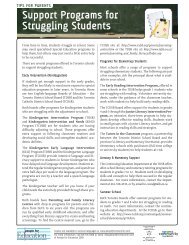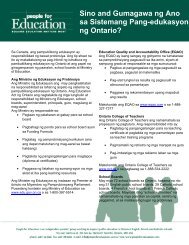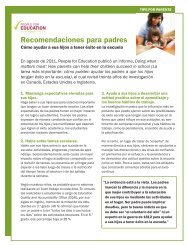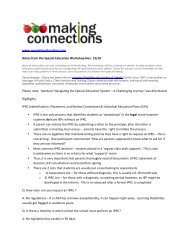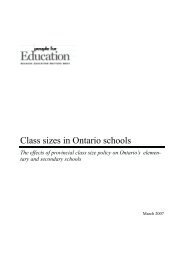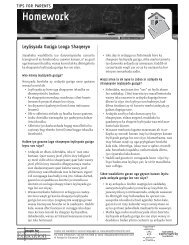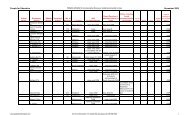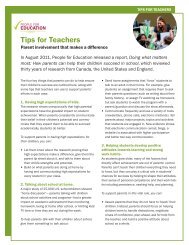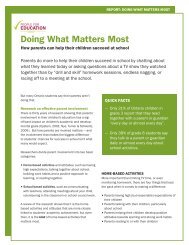Our Children Our Future Our Vision - People for Education
Our Children Our Future Our Vision - People for Education
Our Children Our Future Our Vision - People for Education
Create successful ePaper yourself
Turn your PDF publications into a flip-book with our unique Google optimized e-Paper software.
<strong>Our</strong> <strong>Children</strong>, <strong>Our</strong> <strong>Future</strong>, <strong>Our</strong> <strong>Vision</strong><br />
extensive report included Canada acting on treaty promises with regard to education; proper<br />
funding <strong>for</strong> First Nation controlled education systems; and increased funding <strong>for</strong> post-secondary<br />
education. The RCAP recommendations echoed what had been recommended in numerous reports<br />
be<strong>for</strong>e it and those that would follow.<br />
<strong>Our</strong> <strong>Children</strong>: Keepers of our Sacred Knowledge – 2002<br />
This report resulted from the Minister of Indian Affairs’ National Working Group on <strong>Education</strong><br />
which was created to come up with recommendations on how to improve First Nation education. 106<br />
There were 27 specific recommendations, many of which repeated those of the many reports<br />
which preceded it. The main recommendations included the need to recognize and implement First<br />
Nation jurisdiction over their own education systems; the provision of adequate infrastructure to<br />
support First Nation education systems; funding to cover the real costs of education delivery; and<br />
funding and supports <strong>for</strong> the inclusion of culture and language in First Nation education.<br />
The New Agenda: A Manifesto <strong>for</strong> First Nations <strong>Education</strong> in Ontario – 2004<br />
This is the Manifesto referenced earlier which was the result of extensive research and consultations<br />
with First Nations in Ontario. 107 The overall vision echoed that of First Nations across Canada:<br />
First Nation control over First Nation education. The report is a compendium of papers which focus<br />
on specific areas within education, but all had several common themes: First Nation control over<br />
their own education; adequate resources <strong>for</strong> infrastructure, training, and programs at all levels;<br />
and incorporating language and culture into all aspects of the curriculum and delivery of education.<br />
First Nations Control of First Nations <strong>Education</strong> – 2009<br />
This more recent policy document from the Assembly of First Nations highlighted what activity<br />
has happened since their original Indian Control of Indian <strong>Education</strong> policy statement, as well as<br />
some of the problems that remain. 108 About 518 schools are now located on reserve which deliver<br />
a variety of programs ranging from kindergarten to grade 12 (k-12). There are also 45 Indigenous<br />
Institutes of Higher Learning that provide a variety of adult training and degree programs. 109 Issues<br />
that remain are the need to recognize and implement First Nation jurisdiction; incorporate culture<br />
and language into education; and comprehensive, sustainable, predictable, flexible funding is<br />
required to support First Nation control over education. 110<br />
106 D. Jeffrey, C. Mount Pleasant-Jette, “<strong>Our</strong> <strong>Children</strong>: Keepers of the Sacred Knowledge: Final Report of the Minister’s<br />
National Working Group on <strong>Education</strong>” (Ottawa: INAC, 2002) [<strong>Our</strong> <strong>Children</strong>].<br />
107 Manifesto, supra note 11.<br />
108 First Nations Control, supra note 100.<br />
109 Ibid. at 3.<br />
110 Ibid. at 11.<br />
Chiefs of Ontario<br />
22



